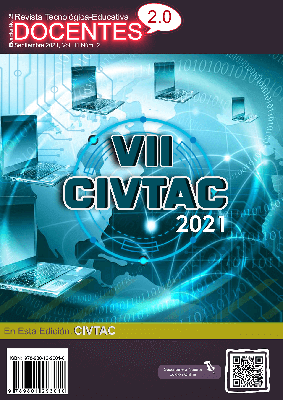Johan Galtung's Conflict Resolution Theory for the Implementation of the Chair of Peace
 DOI:
https://doi.org/10.37843/rted.v11i2.251
DOI:
https://doi.org/10.37843/rted.v11i2.251
Main Article Content
Abstract
To advocate for a culture of peace in a country and a region historically marked by violence is a challenge that must initiate from the schools; these circumstances raise the need to include the La Paz chair in the academic curriculum and face this perspective. The objective of this research focused on analyzing the incidence of the conflict resolution theory of Johan Galtung, which enunciates the concepts of conflict and peace and refers to concrete actions to reduce or eradicate conflicts and favor environments of healthy coexistence the recovery of a culture of peace. Various pedagogical and didactic strategies mediated the application of this theory: Fanzineros for la Paz web page, MY DIARY booklet, diagnostic and exit forms, and tests. The methodology used was qualitative, being the most accurate to investigate social phenomena in which specific objectives are pursued to respond to problems. The population with whom developed the research was between 13 and 14 years of age; it is a group of 34 students. As a result, it was possible to show a decrease in the rates of school violence and, therefore, an improvement in school coexistence and human relations. The main conclusion indicates the re-establishment of a culture of peace, understood as the appropriation of knowledge and citizen skills to construct a healthy coexistence.
Downloads
Metrics
Article Details

This work is licensed under a Creative Commons Attribution-NonCommercial-NoDerivatives 4.0 International License.
Those authors who have publications in our journal accept the following terms:
- When a work is accepted for publication, the author retains rights of reproduction, distribution of his/her article for exploitation in all countries of the world in the format provided by our magazine and any other magnetic medium, optical, and digital.
- Authors will retain their copyright and guarantee the journal the right first to publish their work, which will be simultaneously subject to the Creative Commons Acknowledgment License (Attribution-NonCommercial-NoDerivatives 4.0 International (CC BY-NC-ND 4.0)). That allows third parties to copy and redistribute the material in any medium or format, under the following conditions: Acknowledgment - You must properly acknowledge authorship, provide a link to the license, and indicate if any changes have been made. You may do so in any reasonable way, but not in a way that suggests you have the licensor's endorsement or receive it for your use. NonCommercial - You may not use the material for a commercial purpose. NoDerivatives - If you remix, transform, or build from the material, you cannot broadcast the modified material. There are no additional restrictions - You cannot apply legal terms or technological measures that legally restrict you from doing what the license allows.
- Authors may adopt other non-exclusive license agreements to distribute the published version of the work (e.g., deposit it in an institutional archive or publish it in a monographic volume) provided that the initial publication in this journal is indicated.
- Authors are allowed and recommended to disseminate their work through the Internet (e.g., in institutional telematic archives, repositories, libraries, or their website), producing exciting exchanges and increasing the published work's citations.
- Request of withdrawal an article has to be done in writing by the author to the Editor, becoming effective after a written response from the Editor. For this purpose, the author or authors will send correspondence via e-mail: [email protected].
- The author will not receive financial compensation for the publication of his work.
- All Docentes 2.0 Journal publications are under the Open Journal System (OJS) platform at: https://ojs.docentes20.com/.
References
A?lvarez-Ovallos, A., Ge?lvez-Lo?pez, A. & Mosquera-Te?llez, J. (2020). Conflicto Escolar en la Educación Rural del Nororiente de Colombia. Revista Tecnológica Educativa Docentes 2.0, 9 (2), 5-15. https://doi.org/10.37843/rted.v9i2.135. DOI: https://doi.org/10.37843/rted.v9i2.135
Andrade, A., & Gelvez, A. (2019). Propuesta metodológica para potenciar procesos de convivencia, en los estudiantes de quinto grado de la sede N° 2 en la institución educativa Manuel j del Castillo de Ciénaga magdalena. Revista Tecnológica-Educativa Docentes 2.0, 7(2), 60–65. https://ojs.docentes20.com/index.php/revista-docentes20/article/view/12
Carballeira, E. (2018). El diálogo, la mejor herramienta para resolver conflictos. Servicios sociales 16, (1), https://www.aucal.edu/blog/servicios-sociales-comunidad/resolver-conflictos-mediante-el-dialogo/
Centro Nacional de Memoria Histórica. (2015). Catatumbo: Memorias de vida y dignidad. Editorial Panamericana.
Centro Nacional de Memoria Histórica (2018). Con licencia para desplazar. Masacres y reconfiguración territorial en Tibú, Catatumbo. Editorial Panamericana.
Chaux, E., Lleras, J. & Velásquez, A.M. (2004). Competencias ciudadanas: de los estándares al aula. Una propuesta de integración a las áreas académicas. Editorial Universidad de los Andes. DOI: https://doi.org/10.7440/2004.01
Elliott, J. (1993). El cambio educativo desde la investigación-acción. Editorial Alertes.
Galtung, J. (1984) ¿Hay alternativas?: cuatro caminos hacia la paz y la seguridad. Editorial Fontamara.
Galtung, J. (1985). Sobre la paz. Editorial Fontamara.
Galtung, J. (2003). Paz por medios pacíficos: paz y conflicto, desarrollo y civilización. Editorial Bakeaz,
Galtung, J. (2016). La violencia: cultural, estructural y directa. Editorial Fontamara.
Gaviria, P. & Naranjo-Moreno, J. (2015). Los niños piensan la paz.
Banco de la República de Bogotá.
Marín-Hinestroza I., Triana-Osorio, L. A., Martínez-Saldarriaga, M. G. & Alzate-Berrio, S. M. (2016). Perdón, convivencia y reconciliación en el proceso de paz, desde una mirada psicológica. Revista Poiésis (31). 245-256. DOI: https://doi.org/10.21501/16920945.2114
Lederach, P. (2000). El Abecé de la paz y los conflictos: educación para la paz. Editorial Catarata.
Rosenberg, M. J. (2001). E-learning: strategies for delivering knowledge in the digital age. Editorial McGraw-Hill.
Zurbano, J. (1998). Bases de una Educación para la Paz y la Convivencia. Editorial Fondo de Publicaciones del Gobierno de Navarra.






